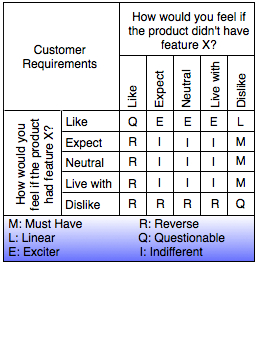Kano Model: Some ThoughtWorks examples
My colleague Jason Yip recently linked to the Kano Model and although it’s a theory about product development the definition of what counts as a product seems like it can be quite broad.
The best explanation of the model that I’ve come across so far is a post by Jean Claude Grosjean which Frankie linked me to.
Grosjean describes the three types of requirements like so:
Must Have ("Basic needs")
These are not always expressed but they are obvious to the customer and must be met…[they] are not a source of satisfaction but can cause major disappointment.
Performance needs ("Linear")
The need is expressed and customer satisfaction is proportional to the level of performance (and quality) of what is implemented.
Delighters ("Exciters")
These requirements are not necessarily expressed. Sometimes they’re unconscious.
This is the happy surprise that can make a difference but if they are not there then there won’t be any dissatisfaction or frustration because they’re not expected.
Exciters are the key to innovation.

To work out which category a requirement fits in Grosjean suggests we ask the following two questions:
-
Functional question: "How would you feel if the product had feature X ?"
-
Dysfunctional question: "How would you feel if the product didn’t have feature X ?"
I was thinking about this idea with respect to scenarios inside an organisation.
I’m anaphylactic allergic to dairy products, eggs, nuts and seafood so my general expectation if I go to any event arranged by ThoughtWorks is that I’ll have to work out for myself what I’ll be able to eat.
However, when I first started working at ThoughtWorks UK in 2006 we had an office manager called Vicki Mott who didn’t leave me to fend for myself.
She would call me up or email me before every event she organised, check what I was allowed to eat and then make sure there was something I could eat at the venue.
I never expected anyone to do that so it was certainly a delighter for me.
In this case the 'product' is more a 'service' being provided by another member of an organisation but I feel that the same theory applies.
Jared Spool explains that what were previously exciters will move to performance needs and then eventually basic needs as time goes on:
One of the predictions that the Kano Model makes is that once customers become accustomed to excitement generator features, those features are not as delightful. The features initially become part of the performance payoff and then eventually migrate to basic expectations.
An interesting example that I can think of which seems to fit this is the way some aspects of travel are dealt with in ThoughtWorks Australia.
In Australia if you are travelling anywhere for ThoughWorks then there will be a driver to drop you to and pick you up from the airport.
When I first saw this it was a delighter for me because I’d never seen anything like it but now it’s become expected which leads to disappointment because we don’t tend to do that in the other countries.
Of course it’s still important that other basic/performance needs are met otherwise the delighters aren’t able to have the same impact but I hadn’t previously thought that much about viewing a service as a product.
About the author
I'm currently working on short form content at ClickHouse. I publish short 5 minute videos showing how to solve data problems on YouTube @LearnDataWithMark. I previously worked on graph analytics at Neo4j, where I also co-authored the O'Reilly Graph Algorithms Book with Amy Hodler.
